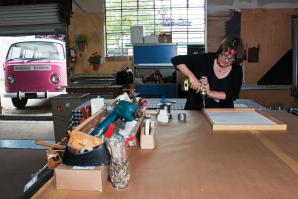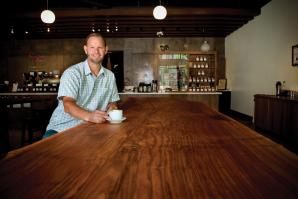Thoughts of living room wallpaper oft conjure memories of Grandma’s bathroom or a great-aunt’s old bungalow. At Bradbury & Bradbury Art Wallpapers in Benicia, the papermakers think that’s just fine.
Producers of hand-printed reproduction wallpapers from the 19th and early 20th centuries, Bradbury & Bradbury has an international reputation for quality and a consumer base boasting three decades of loyalty.
“We don’t go after current trends and the mass market; we go after the historic styles starting in the 1860s and through the 1960s,” says President and Artistic Director Stephen Bauer. “Our collections fit historic homes. We have customers who started decorating their Victorian in the ’80s, and they’re still filling their house with Bradbury & Bradbury wallpaper.”
In a vast studio inside the Benicia Arsenal, eight employees — nearly all of whom have been on board for at least 20 years — painstakingly produce custom wallpaper to order. Veteran colorist Anne Kelly hand mixes paint for each of Bradbury’s 300 patterns, some of which take up to 18 pigments.
Meanwhile, Lead Printer Julian Valdez, also a multidecade employee, screen prints each 30-foot roll of paper yard by yard, color by color, with perfect precision. It’s a quiet, patient job.
Bauer himself says he certainly didn’t envision a life rolled up in wallpaper, but he’s been with the company since its infancy — and by accident.
A lover of historic art, Bauer wrote a letter to a company back east doing 19th century book reprints. As a recent high school graduate from Southern California, he wanted to know how to break into the industry, which schools he should look at and if there were scholarships available. He never heard back, but that letter got passed along to Bruce Bradbury, a Victorian-art aficionado and owner of a one-man wallpaper printing shop.
Bradbury sent Bauer a job offer and a plane ticket, and for the first few years, Bauer called a corner office in the Arsenal home. Public restrooms are down the hall.
In 2005, Bradbury, who is now an icon within his industry, retired and sold the business to Bauer and his wife.
The craftsmen don’t cut corners, and the price tag is justifiably steep — up to $200 a roll for the most labor-intensive papers. But the interior design world is crazy for it. At the company’s sales peak in 1993, decorators and homeowners gobbled up nearly 80,000 yards of paper and paraded it across TV shows including Color Splash, This Old House and Curb Appeal.
One Bradbury pattern, a version of one originally ordered by Queen Victoria for St. James Palace in 1883, was commissioned by George Lucas for the entry to his Skywalker Ranch home. He spent months and nearly $25,000 on the development of the pattern and at one point even had Linda Ronstadt offer her opinion. In the end, he chose an entirely different — and less exciting — paper.
Still, even the less elaborate patterns warrant appreciation. The papers reminiscent of the 1960s are vibrant and playful but simple compared to the meticulously elaborate Colonial Revival patterns of the late 1800s. These patterns, along with the Anglo-Japanese and Persian-themed papers, combine intricate motifs with often more than a dozen colors applied one layer at a time.
“Wallpaper has generally been in decline … but we’re a niche market, … and it really started to grow in the ’80s and ’90s because of restoration,” Bauer says.
In the U.S., the wall coverings industry accounted for nearly $2 billion in sales last year, according to Global Industry Analytics Inc., a San Jose-based market researcher. But the international markets are where the real growth is. The global market for wall coverings (which include not only wallpaper but decorative tile and wall panels as well) is forecast to reach $26 billion by 2015, GIA reports, “boosted by the recovering world economy and the consequent activity in the residential construction sector,” plus demand for refurbishing homes in emerging markets.
Still, while the demand for wall coverings as a whole is trending up, the road for Bradbury & Bradbury certainly isn’t rising at the moment. Sales have been flat since 2008. “When the market went down, we went down, and we stayed there,” says Customer Service Manager Beverly Phillips.
Last year the company sold 55,000 yards of paper.
“But it’s working,” Phillips says. Mostly because Bauer and his wife, Lisa, the company’s CFO, wasted no time expanding their product line and marketing efforts.
“The first thing we did was to try to widen our market,” Bauer says. “The preservation movement has gone forward in time from Victorians … to bungalows. Now, even some houses from the ’70s are being restored. That means the market for historic papers is going forward.”
So Bradbury & Bradbury introduced its line of art deco paper, which immediately resonated with buyers in the United Kingdom, Australia and Russia and has become one of the company’s top sellers.
“We don’t really know when the trends are going to hit, and we don’t know which collections are going to be hot at any given time,” Phillips says. “We get these little geographic patches of sales; art deco in the U.K., a lot of arts-and-crafts papers in New Jersey and recently Victorian-style papers in one neighborhood in New York.”
The Bauers are looking next to papers with greater international appeal. They are also venturing into fabric design, though prudently as to find the right partners and not startle a steadfast consumer base.
At the same time, the mass-market wallpaper industry is coming up with new trends of its own, such as wallpaper cutouts, removable wallpapers and mold-resistant and low-emission wallpapers. According to GIA, the industry is banking on these features to make wallpapers “more user and environment friendly, and increase the segment’s market share.”
Recommended For You

Framed
The hand-carved Italian frame hanging in the back of Archival Framing is priced at $1,400. It surrounds a $10 plastic clock.

Money Tree
New Helvetia Hardwoods is homegrown
Tree aficionado Clark Kayler rescues fallen elms, walnuts, sycamores and redwoods — giants that have lined the streets of midtown Sacramento for more than 100 years — and grants them new life in the form of furniture.



